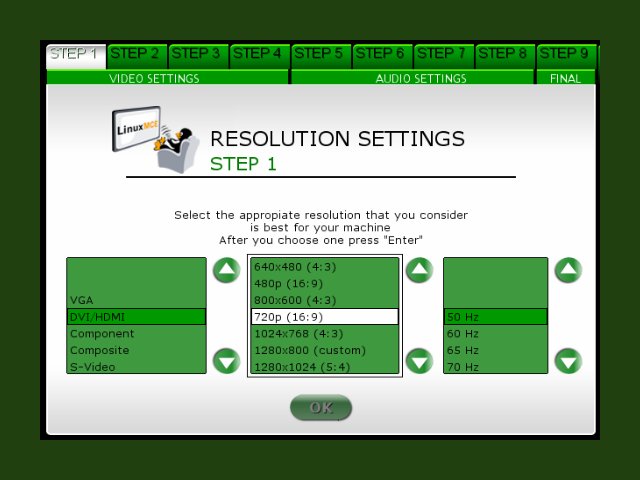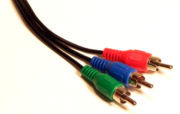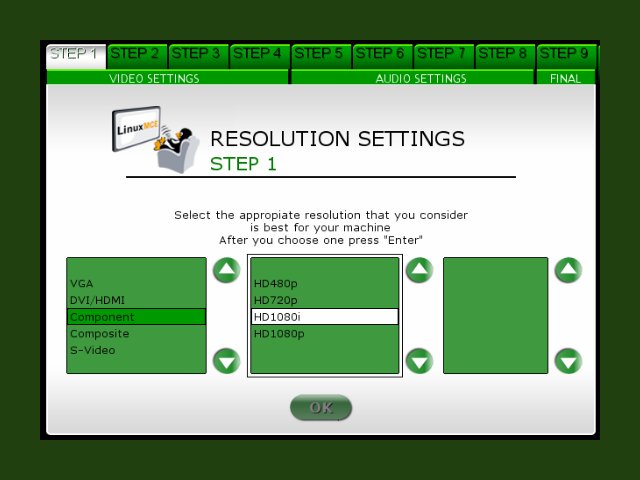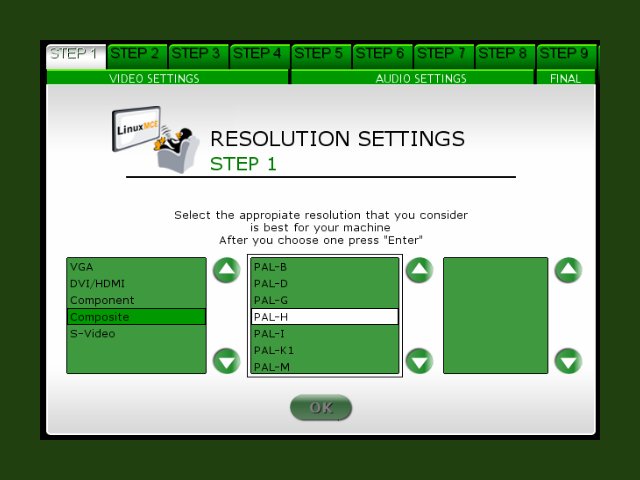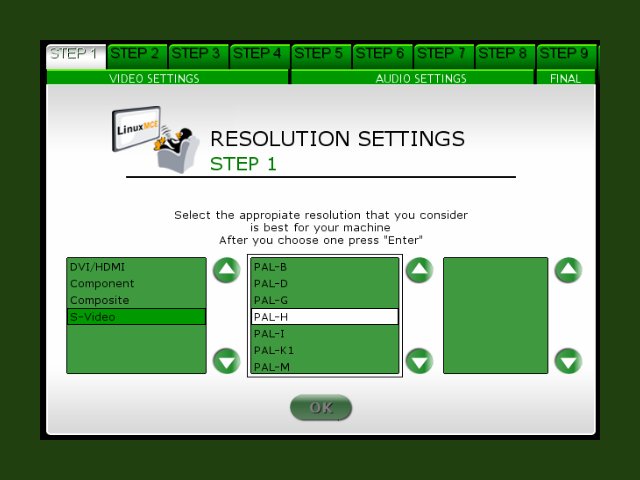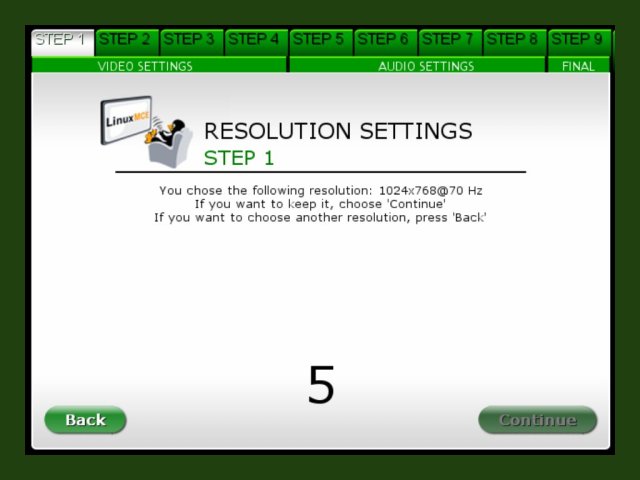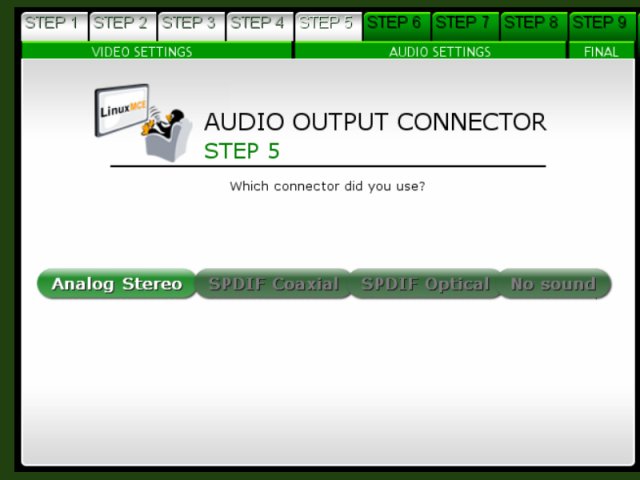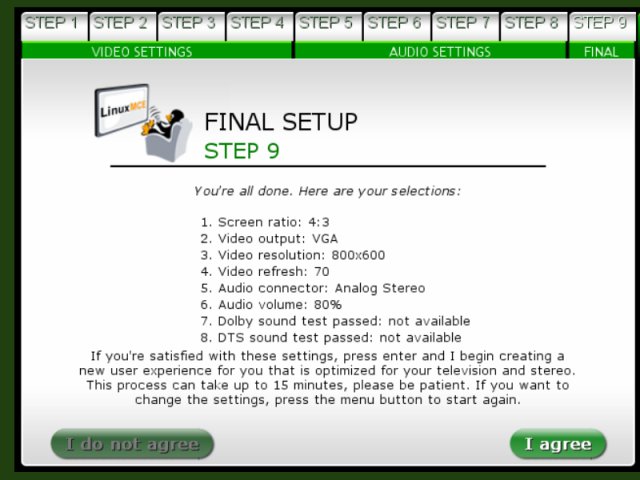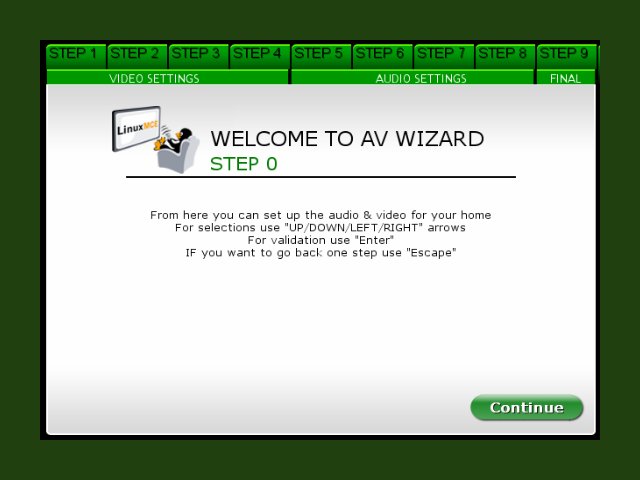AVWizard Step by Step
AV Wizard can be accessed by pressing the Shift key when the Kubuntu with LMCE boots up. In the process of booting, at a time, you'll hear a series of beeps. You must be prepared before these beeps to press the Shift key. When you'll hear them, press Shift key and keep it pressed. Then you'll enter in AV Wizard. If instead of AV Wizard you see black screen or "no signal" message on display, try to switch the connector type as it is described in section II.
Contents
Section I
Resolution Settings
Here, you can choose the desired output from your video card to TV or monitor. If you’ll choose VGA, there are many available resolutions and refresh rates. If you have a LCD TV or LCD monitor there is no need to choose a refresh rate. This is helpful only if you have a CRT monitor.
The resolutions for component are made for using with wide screen monitors and TV’s. Choose the one that is best suited to your display device.
If you are choosing Composite, you can also choose one TV standard from the list, supported by your display.
The screen for setting up S-Video looks like this:
As you can see in the picture above, you will choose one of the TV standards in the list.
Confirmation of Resolution
After choosing a resolution, a counter will appear on your screen which will stay 15 seconds. In this time, you can decide if the resolution is good for your monitor or not. If you like it, press Continue. If not, press Back.
Select Graphical User Interface
The next step of the A/V wizard refers to the graphical aspect of user experience. Here, you have three options:
- Please look a Selecting the Right UI for more information regarding the best option to choose.
• Static images, no overlay (lightweight) – It uses only static images and works on nearly all graphics platforms.
• OpenGL with overlay (medium)
• OpenGL with alpha blending (high-end) - Requires very specific Graphics Cards
- In this case your media is always first and foremost, and the media is always full-screen. If you're not watching any media, Pluto downloads the 'most interesting' photos from flickr.com and presents smooth sliding, cross-fading gallery art as your media.
Adjust Image Size
The wizard will guide you to the adjustment of the image size. The keys + and – from the keyboard will help you to adjust the size of the image. The cursor keys, Up, Down, Left and Right will help you to center the image to the desired position. Once you made the correct setup press OK and go the next screen.
Audio Output Connector
Next set up the audio system. Again, you have to look at the sound card to see where is connected the cable which goes to the sound system. If you connected the cable to the correct output you have only to click the choice on the screen. If you will hear a melody, then everything is ok, you made the correct setup.
Final Confirmation
The final screen of the AV Wizard will show you the settings that you’ve chosen for the LinuxMCE system. If agree these setting press I agree, if not, press I do not agree and you’ll be able to make the settings again.
Section II
Another method to choose the resolutions and the connector is by pressing some keyboard keys. By default, the AV Wizard has the resolution 640x480 on VGA. To choose the connector you have to press the keys from 1 to 5 (1=DVI, 2=VGA, 3=Component, 4=Composite, 5=S-Video). To choose a resolution you have to press the keys from 6 to 0 (6=640x480, 7=1024x768, 8=720p, 9=1080i, 0=1080p). For choosing the resolution and connector you have to be in the initial screen of AV Wizard.
When you are in this screen press the key the desired connector. The screen will flicker and will return to this initial screen. Then, press the key for the desired resolution. Again, the screen will flicker and will return to the initial screen, using the resolution that you chose. After you made the setup, you can continue with the next settings.
Troubleshooting
Driver Issues
- 1080i and 1080p are not fully supported because of some factory issues of NVidia drivers.
The AVWizard does not start
- I hear the beeps but I only have a black screen.
- Please refer to Section II above as it will tell you how to start the AVWizard with a connection other than VGA.


